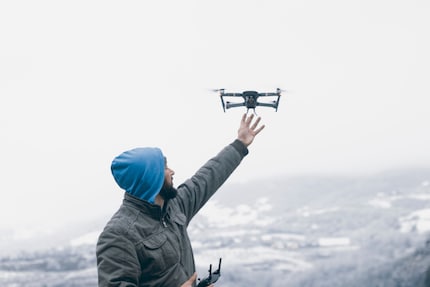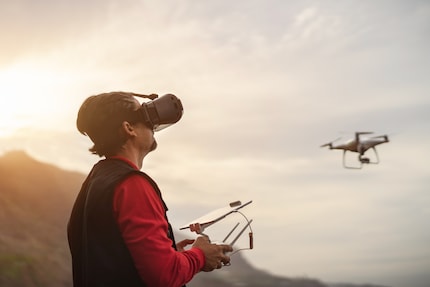
Background information
I'm learning to fly - with the DJI Mavic Air 2
by David Lee

The drone you’ve been dying to get for ages is finally here, and all you want to do is start flying. But it’s not quite as simple as that. Sandra Bodmer, Section Head of Unmanned Aircraft Systems at the Federal Office of Civil Aviation (FOCA), explains the steps you need to take to safely get your drone in the air.
Clutching the parcel containing your new drone, you’re itching to go and try it out. But simply unwrapping the drone and charging the battery isn’t enough to get you ready for take-off. In this interview, Sandra Bodmer, Section Head of Unmanned Aircraft Systems at the Federal Office of Civil Aviation (FOCA), explains insurance and registration requirements for drone users.
Drones make for popular Christmas presents. What are the three most important things somebody who’s been gifted a drone should bear in mind?
Sandra Bodmer: It’s really difficult to pick out just three. The most important things are: don’t fly higher than 120 metres, don’t fly over crowds of people and either get out of the way or land if a plane or helicopter’s approaching. You should also keep your drone grounded if the emergency services are deployed nearby. The same goes for when you’re near airports, nature reserves and a whole bunch of other places. In fact, it’s quite a complex topic. One that requires you to get informed, familiarise yourself with the rules and follow them.
New selfie drones, such as the DJI Neo or the Hover Air X1, are primarily geared towards beginners. Can people with these small, lightweight drones simply start flying right away?
It’d obviously be tempting to just take off, but even drones like the DJI Neo are aircraft, not toys.

What are the specific things you have to do before you can fly a new drone?
First, you have to register as a pilot. You’ve got to be at least 12 years old to do so. The registration rule applies to any drone with a camera and microphone (regardless of weight) and to any drones weighing over 250 grammes (regardless of whether they’re equipped with a camera, microphone or other sensors). You’ll find more detailed information on this on the FOCA website.
What about insurance?
If a drone weighs more than 250 grammes, the pilot’s required to take out liability insurance covering at least one million Swiss francs. There’s no obligation to insure drones weighing less than 250 grammes. Even so, it might still be worth clarifying that point with your insurance company. Even lightweight drones such as selfie drones can cause major damage, and the pilot’s liable in those cases.
What other rules exist around small selfie drones, many of which have automatic flight functions?
Even self-flying drones have to be kept within view at all times when they’re in the air. This means you have to keep a very close eye on the drone and your surroundings and either get out of the way or land in good time if another aircraft’s approaching. That’s because planes and helicopters usually don’t even see drones. At the same time, drone pilots are often unaware of the aviation rules regarding right of way.

Where can you find out if flying a drone over your favourite place is actually allowed?
The first thing you can do is check the FOCA drone map. It shows you all the general area restrictions in place, i.e. areas where drones flights aren’t permitted or are only permitted under certain conditions. If you click on the marked areas, you’ll find out why you’re not allowed to fly in a given location. For example, there might be an airfield nearby, which would require you to get a permit before flying. If you don’t do that, you could be prosecuted.
You also need to check the Notice to Airmen, also known as NOTAM, and the Daily Airspace Bulletin Switzerland, or DABS. There, you can see any additional restrictions or hazard warnings in place.
Let’s go back to your point about registration. On selfie drones, the software largely takes over the flight controls. So, why is it still necessary for users to register?
Even with increasing automation, drone pilots are still responsible for ensuring a safe drone flight. The registration process allows us to assign a drone to a pilot. After registering, you get an operator number, which you can then either stick to your drone or write on it with a waterproof felt-tip pen. Thanks to registration, we’ve been able to return drones that had crashed or were presumed lost to their owners.
You’re also required to register a drone weighing under 250 grammes if it’s capable of capturing personal data. This applies if your drone has a camera or other sensors such as microphones that can be used to make recordings. Rather than relating to the drone’s controls, the registration requirement’s linked to respecting other people’s privacy.

Some people are worried about drones being used to spy on them. Where does that fear come from?
Drones are also used in warfare, which sometimes gives them a negative image. Plus, some people might have had negative experiences with drones or just aren’t aware of the rules surrounding them. This makes people afraid of them.
We’re in a situation I see as absurd, whereby loads of people have phones in their hands at swimming pools, restaurants and in other public spaces, and can use them to film as much as they please. Almost nobody’s bothered by that. However, as soon as there’s a single drone flying around somewhere far away, people are afraid they’re being spied on. Is that concern justified?
The fact is a drone isn’t that far from a smartphone. Phones can also be used to take photos and videos without someone noticing. The only difference compared to a drone is the distance this can be done from. Or, at most, the perspective when filming from the air. However, the same rules on data protection and privacy apply when you’re taking photos or videos on a smartphone. More specifically, you can’t just film other people or their property without asking permission first. So, in my view, the fear of drones being used for spying is mostly unfounded.
These days, it’s not just selfie drones on people’s Christmas lists. It’s also models such as the DJI Mini 4 Pro or the DJI Avata 2. How do you know which rules you have to follow with each one?
Newer drones usually come with a class identification label (C0, C1, C2, C3 or C4). This tells you whether you’re allowed to fly your drone in the A1, A2 or A3 sub-categories, and is based on the weight of your drone. The rules and restrictions relating to these sub-categories are set out on the FOCA website.
Let’s talk about drone licences. Pilot certification is divided into the simpler joint A1/A3 exam and the more challenging A2 exam, which includes a practical section. Should pilots flying drones weighing less than 250 grammes take the A1/A3 test too – even if it’s not mandatory?
Yes, absolutely. We recommend that all drone pilots complete at least the A1/A3 training. You can currently still view the training content online free of charge. There’s also a new page on our website with all the key information for beginners. It has simple explanations of all the most important rules, as well as tools such as our drone guide.
**Who would benefit from getting A2 certification?
An A2 licence is only required if you want to fly in the A2 sub-category. However, unlike the A1/A3 exam, you can’t take the A2 exam online in Switzerland. You can get an A1/A3 or A2 licence in any EU member state or Switzerland. It’ll be accepted in both Switzerland and the EU.
For FPV (first-person view) drones flown using video goggles, you always need an observer there to keep an eye on the drone. However, there’s nothing that observer can do if the connection between the drone and the goggles or the drone and the remote control is disrupted. The obligation to have a second pair of eyes on hand makes it more complicated for amateurs to do spontaneous filming. What’s the reasoning behind this rule?
If a pilot’s flying with video goggles, they see things from the air, as if they’re in a cockpit. But they don’t have direct visual contact with the drone. You usually need a permit for flights like these – unless you have a an observer with you. This observer always has direct visual contact with the drone, so they can immediately tell the pilot if, for example, there’s another aircraft approaching or if people on the ground are at risk. After all, the pilot wearing the video goggles can’t see nearby aircraft or people. They only spot them very late and, as a result, react late too. In other words, it’s a safety measure. If you want to fly your drone while wearing video goggles and you don’t have an observer, you’ll need a permit from the FOCA.

As far as I know, there’s no specific place to report rule-breakers. Do the authorities do spot checks? Or how are the rules enforced?
Rule violations can be reported to both the FOCA and the police. When making a report, it’s important to be as precise as possible and include details such as the offending drone’s operator number or the name of the pilot. Otherwise, it’s really difficult for us to follow up on any infringements of the rules. However, even without reports or information from the public, the police check that people are complying with the rules. As for pilots who require a licence from the FOCA, the FOCA is responsible for policing that.
Unlike with road traffic offences, there’s no catalogue of fines for drones. But there are fines of up to CHF 20,000. How is a fine’s amount determined?
That’s right. The FOCA’s responsible for following up on criminal offences. Fines are dictated by the severity of the offence. Some violations, such as flying near an airport and endangering a manned aircraft, can have serious consequences for the pilot, including prison sentences.
Is there one last tip you’d like to give to people who want a drone for Christmas and want to enjoy their new hobby safely and worry-free?
If you follow the rules, you’ll have a lot of fun with your drone. If there’s something you’re unsure of or if you have any questions, get in touch with us at rpas@bazl.admin.ch
Research diver, outdoor guide and SUP instructor – I love being in, on and around water. Lakes, rivers and the ocean are my playgrounds. For a change of perspective, I look at the world from above while trail running or flying drones.
Interesting facts about products, behind-the-scenes looks at manufacturers and deep-dives on interesting people.
Show all